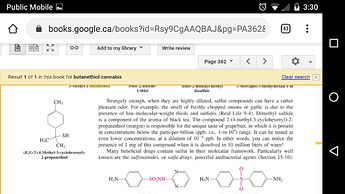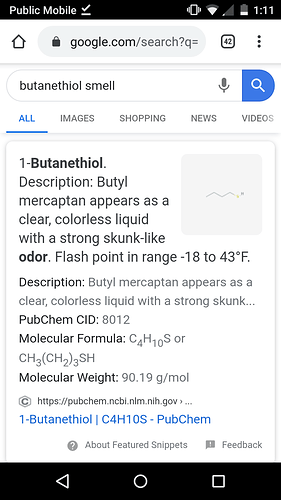I’m just wondering if anyone knows of a lab that tests for thiols/mercaptans in cannabis. Is there a reason that this isn’t done? Has anyone seen a white paper or lab test showing thiols occuring natively in cannabis?
why do you ask?
my knee jerk response to “thiols & mercaptans in cannabis” was
Dude, you’re supposed to use the non-oderized butane!
which isn’t super helpful, or the only source of stinky extract ![]()
@Psilisophical posted a paper about 7 hrs ago that has a pretty extensive list of constituents…I didn’t note any thiols or mercaptans on the list.
I would however imagine, that because every single protein on the planet starts with a Methionine, and methionine can be converted enzymatically to mercaptans in your mouth, boiling “crude” for hrs at a time might yield some…
I’m more after figuring out where the skunky smell in cannabis is coming from. A lot of people are saying thiols. @anon93688 suggested butanethiol, but nobody has shown this. I am told it is because cannabis labs are not equipped to test this because of how big of a hassle it is to make standards for them.
The internet is full of hints towards what it might be but no testing or evidence.
“Cannabis contains alpha-linolenic acid, which may break down under the ultraviolet rays of sunlight into methyl and butyl thiols, according to one scientist’s theory.”
https://www.northbaybusinessjournal.com/northbay/sonomacounty/7008462-181/cannabis-smell-management
With compounds possibly in the single digit ppm or ppb it gets kind of hard to detect I imagine.
I can do an analysis on some cannabis to determine it’s thiol or mercaptan content… For money!
Have you tested any cannabis for it? Have you seen it in a lab test of cannabis flower?
Pixis labs in Oregon will develop methods to test anything you want, if you pay them. Rates aren’t bad either.
I have tested concentrates for it, no bud
That’s what my lab does! We in San Diego
@Krative Have you any lab tests that show it’s presence in non-bho extract? My only thoughts are that the thiol could theoretically come from the butane if that’s the extract source. Seriously, there is nowhere I can find after years of looking as to what definitively causes the skunky smell in cannabis or even a positive test for thiols in the plant itself. Posting results showing it may be the first time it has ever been published in Cannabis literature. If anyone can prove me wrong or prove anything about this, I will be happier then a pig in shit!!
I’m not financially equipped to sponsor such a thing, but if someone did they may be making a scientific breakthrough. There are quite a few thiols to make standards for, and possibly ones never tested that are unique to cannabis. How would you test for something that has no standard?
Also I am in Canada and it would not be possible for me to bring them or @Krative any samples to test.
What’s a particularly skunky strain down there? I may be able to arrange this all when I have some money in my pocket. Too bad I cant bring you guys any pink strains
triple-quad and a library?
then confirm guess ?!?
presence of sulphur should be a decent clue…
Myrcene accounts for a large portion of the gassy smell in extracts. Test results show this in very high correlation. Thiols have never popped up before but I’ll get the gassiest extract I have analysed for them and let you know.
Thank you thank you thank you
I have heard that about myrcene but I don’t believe it. Hops, bay laurel, mango… They all have fairly decent myrcene contents but no skunky smell. In the perfume industry they use super strong thiols to carry smells. Next time you have some really gassy funk try eating some fruit flavoured shit, wait a few minutes then smoke the gas. I have tried this experiment a few times and every time I taste that fruity taste more when I’m hitting the joint then before. Seems like a silly experiment, but with it’s extreme volatility, thiols are able to carry flavours. My theory is that this myrcene theory started because of this and myrcene’s love for bonding to everything. It should be fairly hard to detect when in a ppb range and possibly bonded/azeotroped right?
The grapefruit […]propanethiol can be tasted diluted to 1mg in 10 000 000 L/2 641 720 Gallons of water
Also, is it possible for you to detect a thiol you dont have a standard for?
Yeah we can compare it to the gc-ms database to identify samples we don’t have standards for, so long as they have been identified and documented in the past by someone. So dab some skunk then eat some fruit? I can try that
@Krative Eat it first, works better with fruit candy like starburst haha. Would it still be detectable in ppb range?
Butanethiol smells like toasted sesame oil. I think it’s used as an artificial lavoring ingredient for that purpose too. Cheap Chinese food smell
@MediumTroy Thiols have very different smells at different concentrations, some even smell fruity. The main thiol in BO smells bad but has a fruity mirror image. A lot are used for artificial meat flavouring in food, but also some are used to carry aroma further in the air as is the case with perfumes. Butanethiol has definitely been described as skunky, present in its wikipedia entry for instance. I once had some blueberry x trainwreck that was nothing but skunk in the air. One gram under my bed stunk the whole house with skunk, yet when you smelled it up close it smelled like blueberry pancakes with blueberry syrup… Thiols are very elusive it seems.
I did some research on butanethiol, it was not cannabis skunky in any concentration I’ve smelled. You can buy some “skunk spray” which is mostly butanethiol. It smells like toasted sesame, aka Panda Express aka pf chang… It doesn’t smell like cannabis. Here’s a paper where it is listed as a main component of sesame flavor. I’m also curious about the missing components which make cannabis skunky, I think butanethiol should be ruled out though, try it for yourself.
Flavor Design of Sesame-flavored Dressing Using Gas Chromatography … - J-Stage
12_261.pdf (959.9 KB)
I appreciate that, but curious why so many have described it as skunky then. I would not rule it out though as what we smell is most likely a thiol carrying other smells/terpenes. I would say mix some of that with some botanical terps/cdt and see how it smells mixed. Also I can guarantee that it was not mostly butanethiol. Was it artificial skunk spray or skunk essence? What brand and how do you know the level of butanethiol it contained?
@qma ? @anon93688 ?
Down to 15 ppb

